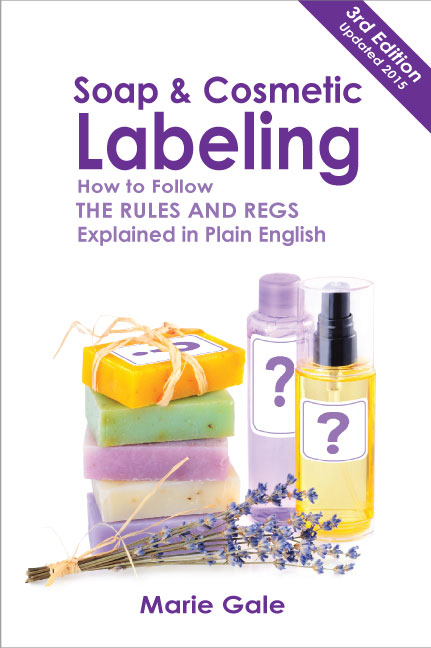One of the myths that I still frequently hear is that “I can put whatever I want on my soap labels because they aren’t regulated.” I believe that particular myth got started because of the “soap exemption” in the FDA’s definition of “cosmetic:”
Directly from the regulations:
A product, except soap, intended to be applied to the human body for cleansing, beautifying, promoting attractiveness or altering the appearance.
Food, Drug and Cosmetic Act, 21 USC 321(i)
Right! Soap can be exempted from the definition of a cosmetic (and thus the labeling regulations for cosmetics). But there are still other regulations that apply to the labeling of soap.
Fair Packaging and Labeling Act
The Fair Packaging and Labeling Act was passed in the late 1960s. The first paragraph is the “Congressional declaration of policy” which states:
Directly from the regulations:
Informed consumers are essential to the fair and efficient functioning of a free market economy. Packages and their labels should enable consumers to obtain accurate inforamtion as to the quantity of contents and should facilitate value comaprisons.
FPLA: Section 1451
The law is very specific about the fact that it is addressing the issue of labeling products, including soap.:
Directly from the regulations:
Unfair and deceptive packaging and labeling; scope of prohibition.
(a) Nonconforming labels. It shall be unlawful for any person engaged in the packaging or labeling of any consumer commodity … to distribute … any such commodity if such commodity is contained in a package, or if there is affixed to that commodity a label, which does not conform to the provisions of this chapter and of regulations promulgated under the authority of this chapter.
FPLA
The Labeling LAW
The FPLA, which is the law itself, is specific about what has to go on the label. It includes:
- The identity of the commodity;1
- The name and place of business of the manufacturer, packer or distributor;2
- The net quantity of contents, separately and accurately stated, for liquid products in fluid ounces, and for solid products in ounces by weight.3 4
This labeling law applies to all consumer commodities, including soap and cosmetics.
The difference between soap and cosmetics is that the FDA was given authority to create regulations for cosmetics (as well as foods, drugs, and devices), and the FTC was given authority to create regulations for other products (including soap).
The Labeling REGULATIONS
For consumer commodities generally (including soap), the FTC created regulations (Title 16, Commercial Practices, Part 500, Sections 500.1 to 500.29) which specifically detail what must go on the label of every product (including soap). These regulations go into greater detail and specificity on how each of the three items required by law must actually be done.
These regulations include such things as where the information must be placed, how to calculate the correct text size, when the street address may be omitted from the label, acceptable methods to identify the product, etc.
The regulations require that the net contents are presented in both inch/pound (i.e. ounces and fluid ounces) and in metric (i.e. grams, milliliters).
State Regulations
In order to keep things coordinated throughout the United States, most states have adopted some form the Uniform Product Labeling Regulations, which are suggested state-level regulations dealing with product labeling. They are essentially the same as the federal-level regulations created by the FTC.
If you’re making soap (exempt from the definition of a cosmetic) you are subject to not only the federal laws and regulations, but also the state-level laws and regulations. If your labels do not comply, you are subject to enforcement at both the state and federal level (depending on who catches you).
And more regulations …
In addition to the Fair Packaging and Labeling Act, there are other regulations that apply to soap:
- Required reporting to the Consumer Product Safety Commission of any unsafe product (e.g., if you were sued over a soap being harmful in some way).
- Certification of scales used to weigh products for commercial sale (generally at a state level; often under the Department of Agriculture).
- Laws and regulations at both the state and federal level covering contests, sweepstakes, and lotteries (if you’re offering free give-aways, for example).
- Fair and non-deceptive advertising laws and regulations.
- Green or environmental claims about your product or packaging.
- Identification of organic ingredients or products.
- “Made in the USA” claims, which must meet very specific requirements.
Just a Myth
In the end, like unicorns and fairies, it is just a myth that soap is exempt from labeling regulations.




Leave a Reply